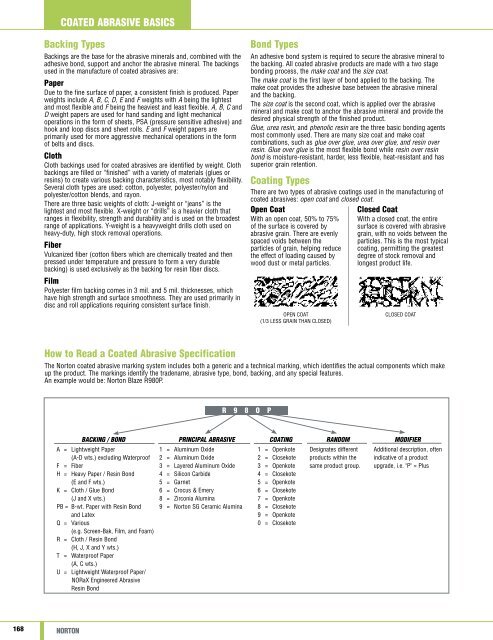You also want an ePaper? Increase the reach of your titles
YUMPU automatically turns print PDFs into web optimized ePapers that Google loves.
Coated Abrasive Basics<br />
Backing Types<br />
Backings are the base for the abrasive minerals and, combined with the<br />
adhesive bond, support and anchor the abrasive mineral. The backings<br />
used in the manufacture of coated abrasives are:<br />
Paper<br />
Due to the fine surface of paper, a consistent finish is produced. Paper<br />
weights include A, B, C, D, E and F weights with A being the lightest<br />
and most flexible and F being the heaviest and least flexible. A, B, C and<br />
D weight papers are used for hand sanding and light mechanical<br />
operations in the form of sheets, PSA (pressure sensitive adhesive) and<br />
hook and loop discs and sheet rolls. E and F weight papers are<br />
primarily used for more aggressive mechanical operations in the form<br />
of belts and discs.<br />
Cloth<br />
Cloth backings used for coated abrasives are identified by weight. Cloth<br />
backings are filled or “finished” with a variety of materials (glues or<br />
resins) to create various backing characteristics, most notably flexibility.<br />
Several cloth types are used: cotton, polyester, polyester/nylon and<br />
polyester/cotton blends, and rayon.<br />
There are three basic weights of cloth: J-weight or “jeans” is the<br />
lightest and most flexible. X-weight or “drills” is a heavier cloth that<br />
ranges in flexibility, strength and durability and is used on the broadest<br />
range of applications. Y-weight is a heavyweight drills cloth used on<br />
heavy-duty, high stock removal operations.<br />
Fiber<br />
Vulcanized fiber (cotton fibers which are chemically treated and then<br />
pressed under temperature and pressure to form a very durable<br />
backing) is used exclusively as the backing for resin fiber discs.<br />
Film<br />
Polyester film backing comes in 3 mil. and 5 mil. thicknesses, which<br />
have high strength and surface smoothness. They are used primarily in<br />
disc and roll applications requiring consistent surface finish.<br />
Bond Types<br />
An adhesive bond system is required to secure the abrasive mineral to<br />
the backing. All coated abrasive products are made with a two stage<br />
bonding process, the make coat and the size coat.<br />
The make coat is the first layer of bond applied to the backing. The<br />
make coat provides the adhesive base between the abrasive mineral<br />
and the backing.<br />
The size coat is the second coat, which is applied over the abrasive<br />
mineral and make coat to anchor the abrasive mineral and provide the<br />
desired physical strength of the finished product.<br />
Glue, urea resin, and phenolic resin are the three basic bonding agents<br />
most commonly used. There are many size coat and make coat<br />
combinations, such as glue over glue, urea over glue, and resin over<br />
resin. Glue over glue is the most flexible bond while resin over resin<br />
bond is moisture-resistant, harder, less flexible, heat-resistant and has<br />
superior grain retention.<br />
Coating Types<br />
There are two types of abrasive coatings used in the manufacturing of<br />
coated abrasives: open coat and closed coat.<br />
Open Coat<br />
With an open coat, 50% to 75%<br />
of the surface is covered by<br />
abrasive grain. There are evenly<br />
spaced voids between the<br />
particles of grain, helping reduce<br />
the effect of loading caused by<br />
wood dust or metal particles.<br />
Open Coat<br />
(1/3 less grain than Closed)<br />
Closed Coat<br />
With a closed coat, the entire<br />
surface is covered with abrasive<br />
grain, with no voids between the<br />
particles. This is the most typical<br />
coating, permitting the greatest<br />
degree of stock removal and<br />
longest product life.<br />
Closed Coat<br />
How to Read a Coated Abrasive Specification<br />
The <strong>Norton</strong> coated abrasive marking system includes both a generic and a technical marking, which identifies the actual components which make<br />
up the product. The markings identify the tradename, abrasive type, bond, backing, and any special features.<br />
An example would be: <strong>Norton</strong> Blaze R980P.<br />
R 9 8 O P<br />
Backing / Bond Principal Abrasive Coating Random Modifier<br />
A = Lightweight Paper<br />
(A-D wts.) excluding Waterproof<br />
F = Fiber<br />
H = Heavy Paper / Resin Bond<br />
(E and F wts.)<br />
K = Cloth / Glue Bond<br />
(J and X wts.)<br />
PB = B-wt. Paper with Resin Bond<br />
and Latex<br />
Q = Various<br />
(e.g. Screen-Bak, Film, and Foam)<br />
R = Cloth / Resin Bond<br />
(H, J, X and Y wts.)<br />
T = Waterproof Paper<br />
(A, C wts.)<br />
U = Lightweight Waterproof Paper/<br />
NORaX Engineered Abrasive<br />
Resin Bond<br />
1 = Aluminum Oxide<br />
2 = Aluminum Oxide<br />
3 = Layered Aluminum Oxide<br />
4 = Silicon Carbide<br />
5 = Garnet<br />
6 = Crocus & Emery<br />
8 = Zirconia Alumina<br />
9 = <strong>Norton</strong> SG Ceramic Alumina<br />
1 = Openkote<br />
2 = Closekote<br />
3 = Openkote<br />
4 = Closekote<br />
5 = Openkote<br />
6 = Closekote<br />
7 = Openkote<br />
8 = Closekote<br />
9 = Openkote<br />
0 = Closekote<br />
Designates different<br />
products within the<br />
same product group.<br />
Additional description, often<br />
indicative of a product<br />
upgrade, i.e. "P" = Plus<br />
168 NORTON

















